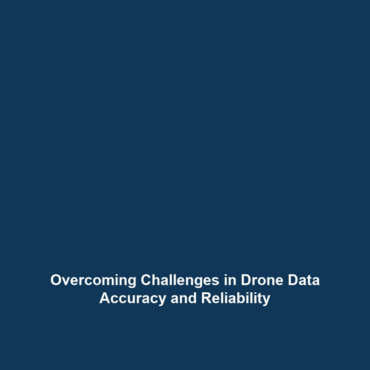Challenges in Ensuring the Accuracy and Reliability of Data Collected by Drones
Category: Drones in Science
Introduction
As the utilization of drones in science expands, ensuring the accuracy and reliability of data they collect has become paramount. The significance of addressing these challenges in ensuring the accuracy and reliability of data collected by drones lies in its potential to impact various scientific fields—from environmental monitoring to agriculture. The advancement of drone technology offers unprecedented opportunities, but researchers must navigate complexities in data validation and real-time analysis to fully harness these innovations.
Key Concepts
Data Accuracy
Data accuracy refers to how close the collected data is to the true value. In the context of drones in science, factors such as calibration, sensor precision, and environmental conditions play crucial roles. Understanding these elements is essential for rectifying any discrepancies.
Data Reliability
Reliability measures the consistency of data collection over time. For scientific applications, it is critical that data gathered by drones produces similar results under equivalent conditions. This consistency is integral for scientists to draw valid conclusions.
Applications and Real-World Uses
The challenges of ensuring accuracy and reliability of data collected by drones manifest in several real-world applications, including:
- Environmental Monitoring: Drones are used for tracking deforestation, pollution levels, and wildlife populations, where data integrity is key.
- Agricultural Assessment: Farmers utilize drones to monitor crop health but must ensure that the data reflecting soil moisture or nutrient content is accurate for effective decision-making.
- Disaster Management: Post-disaster assessments rely on drone technology, where reliable data can inform rescue operations and recovery strategies.
Current Challenges
Studying or applying the challenges in ensuring the accuracy and reliability of data collected by drones involves several limitations, including:
- Sensor Limitations: Different sensors have varying levels of accuracy, influencing data quality.
- Environmental Factors: Weather conditions can distort data collection, leading to inaccuracies.
- Data Processing: The need for advanced data algorithms can introduce complications and potential errors.
Future Research and Innovations
Future innovations aimed at enhancing the accuracy and reliability of data collected by drones include:
- AI Integration: The use of artificial intelligence to improve data analysis and decision-making processes.
- Advanced Sensors: Development of high-precision sensors that can minimize discrepancies in data collection.
- Automated Calibration: Methods to automate the calibration process of drones to ensure consistent performance in varied environments.
Conclusion
In summary, the challenges in ensuring the accuracy and reliability of data collected by drones are critical considerations for enhancing the efficacy of drones in science. As researchers face the growing demand for reliable data, ongoing innovations and rigorous studies are essential. To discover more about the use of drones in various scientific domains, consider visiting our pages on Environmental Monitoring and Agricultural Assessment.

